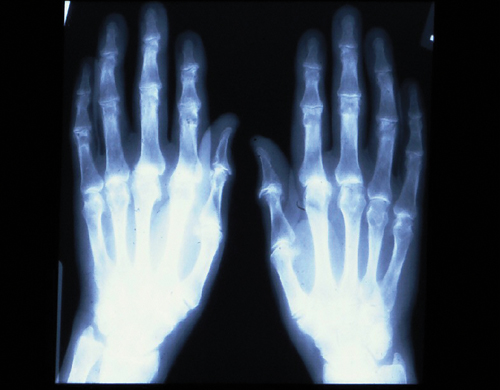Winter 2015 (Volume 25, Number 4)
Top Ten Things Rheumatologists Should (And Might Not) Know About Detection and Treatment of Hemochromatosis
By Justin Cottrell; and Paul Adams, MD, FRCPC
Download PDF
This brief report summarizes some common issues related to hereditary hemochromatosis (HH) and its impact on patients with comorbid rheumatic diseases.
1. HH screening.Individuals with HH and iron overload without related complications benefit from early diagnosis and treatment. Population screening is not recommended.1 A serum transferrin saturation and ferritin concentration is appropriate for initial diagnosis and for screening first-degree relatives of patients with HH.
2. HH and iron overload diagnosis.Homozygosity for the C282Y mutation in the HFE gene is typical. Iron overload is suspected by a ferritin > 300 µg/L in men or > 200 µg/L in women. Transferrin saturation is often elevated but has significant biological variability.2
3. Genetic testing.In most provinces, genetic testing for the C282Y and H63D mutations of the HFE gene is done in provincial laboratories without charge. Genetic testing for rare iron genes (e.g., ferroportin, hemojuvelin, hepcidin, transferrin receptor 2) is available but not recommended; you can find out more at invitae.com. Due
to stigmatization, genetic testing of children is not
recommended.
4. False positive elevations in iron tests.Serum ferritin commonly rises with inflammation; other causes of an elevated ferritin include daily alcohol use, obesity, and fatty liver.3 Extreme elevations of serum ferritin can be seen in histiocytosis and Still’s Disease. None of these conditions have iron overload.
5. HH treatment.Phlebotomy (500 mL) once a week until iron levels return to normal is the primary treatment for HH and serum ferritin levels should be checked monthly or bi-monthly.4 Maintenance phlebotomy is not always required, particularly in women. Avoidance of iron supplements, vitamin C supplements, and uncooked shellfish is also recommended.
6. HH arthropathy distribution.Chronic, indolent pain and joint stiffness of the joints, including the wrists, knees, hips, feet, shoulders, and ankles may be observed. Arthropathy is generally symmetrical and polyarticular. Acute bilateral destruction of the metacarpophalangeal joints (Figure 1) may resemble rheumatoid arthritis (RA); however bony swelling may occur which is indistinguishable from pyrophosphate-associated arthropathy. Disease-specific changes include subchondral radiolucency of the femoral head with atypical stripping of
the cartilage from subchondral bone, and hook-like osteophytes on the second and third metacarpal heads.

Figure 1. X-rays of the hands of a surgeon with hemochromatosis, who could not operate because of pain in the knuckles.
7. HH arthropathy findings.Histological changes include abnormal iron deposits, minimal synovial inflammation, and calcium pyrophosphate dihydrate (CPPD) deposition, particularly in the knees and triangular cartilage. Synovial histology in HH arthropathy resembles osteoarthritis (OA) but increased neutrophils are
present.
8. HH arthropathy treatment.Control of symptoms using analgesics, nonsteroidal anti-inflammatory drugs (NSAIDs), and acetaminophen is beneficial. In severe cases, joint replacement is warranted and is more frequent in hemochromatosis patients.5
9. Other HH symptoms.End organ damage can lead to liver enlargement, fibrosis, cirrhosis, liver failure or death and increased risk for developing liver cancer. Weakness, lethargy, darkness of the skin, diabetes mellitus, heart disease, thyroid disease, and reproductive problems due to pituitary abnormalities leading to impotence, loss of libido, amenorrhea and generalized osteoporosis may be present.
10. Other iron overload syndromes.Other iron overload syndromes include transfusional iron overload, juvenile hemochromatosis, aceruloplasminemia, African iron overload, neonatal, or perinatal iron overload.
References
1. Adams PC, Barton JC, McLaren GD, et al. Screening for iron overload: Lessons from the HEIRS Study. Can J Gastroenterol 2009; 23(11):769-72.
2. Adams PC, Reboussin DM, Press RD, et al. Biological variability of transferrin saturation and unsaturated iron binding capacity. Am J Med 2007; 120(11):999.e1-7.
3. Wong K, Adams PC. The diversity of liver diseases associated with an elevated serum ferritin. Can J Gastroenterol 2006; 20(7):467-70.
4. Adams PC, Barton JC. How I Treat Hemochromatosis. Blood 2010; 116(3):317-25.
5. Emberg M, Hultcrantz R, Simard JF, Carlsson A, Askling J. Increased risk of arthopathies and joint replacement surgery in patients with genetic hemochromatosis: a study of 2,521 patients and their 11,794 first-degree relatives. Arthritis Care Res 2013;65:678-685.
Justin Cottrell
Schulich School of Medicine and Dentistry,
London, Ontario
Paul Adams, MD, FRCPC
Department of Medicine,
University Hospital,
Western University
London, Ontario |



